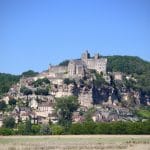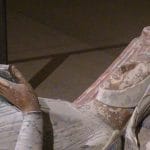Something that gives me just the tiniest frisson – connections between tours.
I’ll give you an example, from our Dordogne and Loire Valley tours. One of the striking features about the Dordogne is the way that the history between England and France going back to the 12th century shaped the landscape we see today. This is a region that saw 4 centuries of fighting in a 500 year period, beginning with the marriage of Henry Plantagenet, heir to the English throne, to Eleanor of Aquitaine. The Dordogne river was the boundary between Aquitaine, belonging to the King of England, and France. There was fighting for 200 years along the Dordogne, finally erupting into The Hundred Years War in 1337.


And on our first day of cycling in the Loire Valley we visit the Royal Abbey of Fontevraud, resting place of Henry, Eleanor, Richard the Lionheart, and their daughter-in-law Isabelle of Angouleme, Prince (later King) John’s wife.


On our newest tour, of Champagne, we visit Reims, the capital of Champagne. Anyone given half the chance should visit the Cathedral of Reims, “Our Lady of Reims”. This was Charles VII’s target, the cathedral where all but 7 of France’s monarchs were crowned, dating all the way back to Clovis 1st in 509 AD.
It doesn’t sound such an amazing thing these days, to tell the King to go to Reims – get a TGV from Tours, change in Paris. But in the early 15th Century it meant crossing hundreds of Kilometres of territory held by the enemy English and Burgundians. In France, they go a bit potty for anything to do with Joan of Arc. If she’d asked the King to post a letter, there’d be a statue and a plaque!
Reims also links to our Normandy tour. We spend the last 3 days of our Normandy tour exploring the monuments, cemeteries and memorials of Operation Overlord, the invasion of Normandy. Here is where the end of the Second World War began. Reims is where it ended.
It seems to be a little-known fact that the surrender of Nazi Germany was signed in what is now the Museum of Surrender in a northern suburb of Reims. A tiny musuem, and overshadowed because Stalin insisted on another ceremony in terriotry liberated by the Soviet Union. This took place the following day in Berlin, on May 8th 1945 – VE day. But the surrender was signed on May 7th. In Reims.

And here’s my favourite ‘connection’. On our Paris tour, obviously we visited the Louvre, where we could see the throngs gathered around the Mona Lisa. In 1939, to save the artworks from the Nazis, the artworks from the Louvre were boxed-up and shipped out. As an aside, each crate was labelled with a code identifying the value of the contents. A yellow circle indicated very valuable art, green was reserved for ‘major works’ and red for ‘world treasures’. The Mona Lisa was given 3 red circles!
All the treasures were sent to Chateau Chambord in the Loire Valley. From there various artworks were transported from chateau to chateau for safekeeping, and the Mona Lisa ended up in the Château de Montal. Which we cycle right past on Wednesday morning of our Dordogne tour, on the way in to St Céré.

On our tours we do make a point of exploring some of the history of each region, so it’s no huge surprise to find that regions of France have historical links with each other. But I like it!


